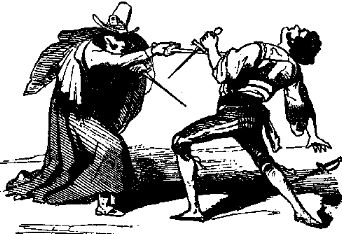1. Action
A duel of back and forth rapier thrusts soon becomes too much, too similar. The best sort of action for describing in words is more distinctive, more memorable.
 For example: one duellist, wounded in the leg, has to fight on while standing, perhaps half-kneeling, on a single spot; or one duellist has the rapier flicked from his hand and has to scrabble to re-gather it before his opponent can deliver the coup de grace; or one duellist traps and immobilises his opponent’s rapier under his armpit. For example: one duellist, wounded in the leg, has to fight on while standing, perhaps half-kneeling, on a single spot; or one duellist has the rapier flicked from his hand and has to scrabble to re-gather it before his opponent can deliver the coup de grace; or one duellist traps and immobilises his opponent’s rapier under his armpit.
When I’m trying to make action interesting, I always look to see if the setting can contribute. Where does the duel take place? Perhaps there are low-hanging tree-branches—so much you could do with that. Or maybe cloaks discarded and lying on the ground—further action possibilities. Or a rising sun that might dazzle the eyes …
In Song of the Slums, there's a great confrontation in the cobbled courtyard of the Houses of Parliament. Astor and Verrol and the other band members need to break through the opposing lines of ex-soldiers. How? There are the cobbles just waiting to be used! They use a knife to prise up the stones and use them as missiles against the ex-soldiers.
Earlier, when the street kids passed through the ground floor of the Houses of Parliament, there were oil paintings hung on the walls - just as an obvious bit of description to convey the formal old-fashioned atmosphere of the rooms. But when the street kids need to take on the ex-soldiers armed with bayonets, they could hardly stand against them without some form of shield. Guess what I used!
The more unusual the setting, the easier for the author to generate unusual developments in the action. There’s just one qualification: the setting has to be already present and in place. You can’t go suddenly discovering low-hanging tree-branches only when the action needs them. It’s a bad look! With that first Song of the Slums example, the knife was already in Verrol's hand before the cobbles needed digging up.
Film directors aim to make action distinctive and memorable too, and they’ve repeated many of the most obvious bits of business so many times they’ve turned into clichés. Maybe you thought that about my example of someone scrabbling to re-gather a weapon, rolling aside just as the opponent’s blow slices down? Yeah, it summons up memories of a hundred movies.
The only saving grace is ... chunking ->
|





